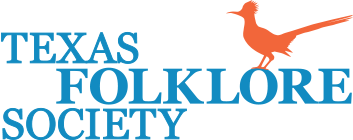Our History
‛‛The key to our continuance, despite our differences, has always been our appreciation of those differences and our love and respect for one another.’’ F.E. "AB" ABERNETHY
The Texas Folklore Society is the oldest state folklore organization continually functioning in the United States. We meet each year on Easter weekend (Thursday night through Saturday at noon), when members sing folk songs and play folk instruments at a hootenanny, tell tall tales, and present papers on a variety of folklore subjects. All sessions are open to the public. Annual meetings have continued regularly since 1911, except for interruptions in 1918-1921 and 1944-1945 caused by the great wars and their after-effects, and in 2020 when the coronavirus pandemic forced the meeting's cancellation.
With a diverse interest in research areas, the Society has published over 100 volumes of folklore-related works, from pamphlets on folk songs to full-length hardcover books on topics such as the Mexican rodeo, folk music, death customs and superstitions, and the importance of food traditions. The Texas Folklore Society has brought to Texas and sent out from Texas the finest scholars and lecturers in the field of folklore, and it has sponsored programs displaying folk arts from Texas and the world. Here is a little about how we got where we are today:
Our Founding and early years (1909-1921)
university of texas at austin
Lomax, Payne, and Thompson
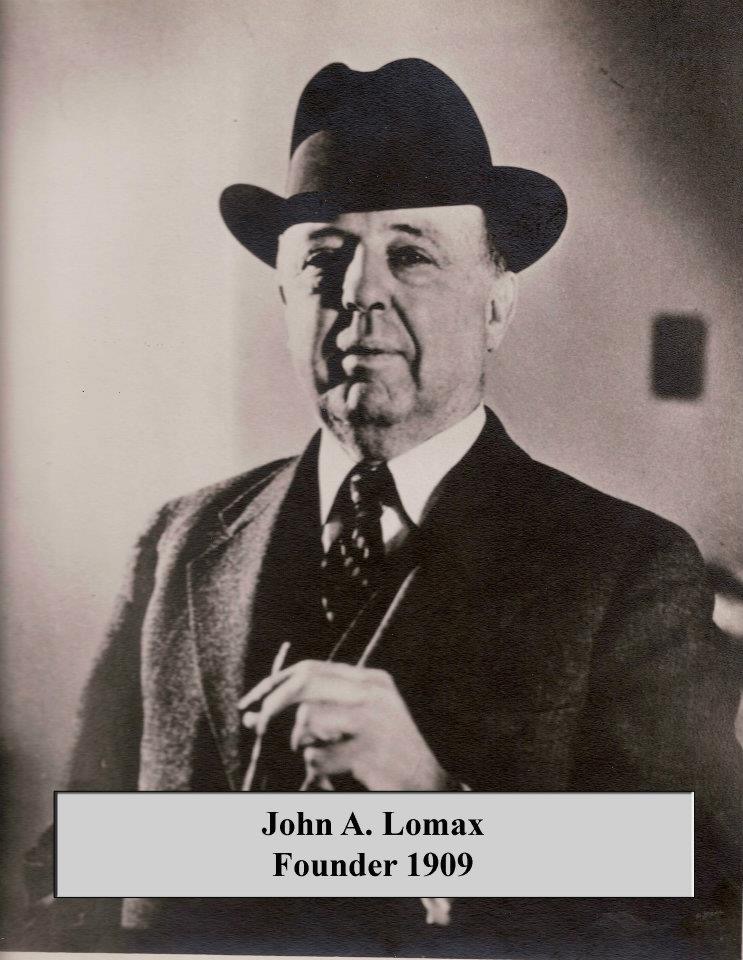 In 1906, John Avery Lomax attended a meeting of the American Folklore Society at Harvard University. Lomax took with him the cowboy songs that he had been learning and collecting since his boyhood days in Bosque County. George Lyman Kittredge of Harvard and others were delighted with the songs and sent Lomax home to Texas with the task of establishing a branch of the American Folklore Society for the purpose of further collecting Texas folklore. Lomax began teaching at Texas A&M and came to know Leonidas Warren Payne of the University of Texas. In 1909, after the Thanksgiving Day Texas and Texas A&M football game, the two met and devised an organizational plan. The Society was officially chartered at the Texas State Teachers Association meeting in Dallas on December 29, 1909. Charter membership closed with ninety-two members, the initiation fee was fifty cents, and annual dues were a dollar. Soon Lomax would move to the University of Texas at Austin and would serve in an administrative capacity in promoting the university.
In 1906, John Avery Lomax attended a meeting of the American Folklore Society at Harvard University. Lomax took with him the cowboy songs that he had been learning and collecting since his boyhood days in Bosque County. George Lyman Kittredge of Harvard and others were delighted with the songs and sent Lomax home to Texas with the task of establishing a branch of the American Folklore Society for the purpose of further collecting Texas folklore. Lomax began teaching at Texas A&M and came to know Leonidas Warren Payne of the University of Texas. In 1909, after the Thanksgiving Day Texas and Texas A&M football game, the two met and devised an organizational plan. The Society was officially chartered at the Texas State Teachers Association meeting in Dallas on December 29, 1909. Charter membership closed with ninety-two members, the initiation fee was fifty cents, and annual dues were a dollar. Soon Lomax would move to the University of Texas at Austin and would serve in an administrative capacity in promoting the university.
 The founders, Lomax and Payne, made significant strides together because of their differences. Their personalities were different, and so were their attitudes about the collection and presentation of folklore. Payne was a literary scholar who studied the philosophy of folklore and made recommendations for the exact specifications for collection. Lomax was more of a romantic, whose song-collecting trips took him to forty-seven states. They worked well together and remained friends, laying the foundation for who we are today. One of Lomax's most treasured legacies is that he was keenly interested in getting the general public involved in collecting folklore themselves--not just leaving it to the academicians. Lomax long believed that there were many fields to plow when searching for the folklore of Texas and the Southwest.
The founders, Lomax and Payne, made significant strides together because of their differences. Their personalities were different, and so were their attitudes about the collection and presentation of folklore. Payne was a literary scholar who studied the philosophy of folklore and made recommendations for the exact specifications for collection. Lomax was more of a romantic, whose song-collecting trips took him to forty-seven states. They worked well together and remained friends, laying the foundation for who we are today. One of Lomax's most treasured legacies is that he was keenly interested in getting the general public involved in collecting folklore themselves--not just leaving it to the academicians. Lomax long believed that there were many fields to plow when searching for the folklore of Texas and the Southwest.
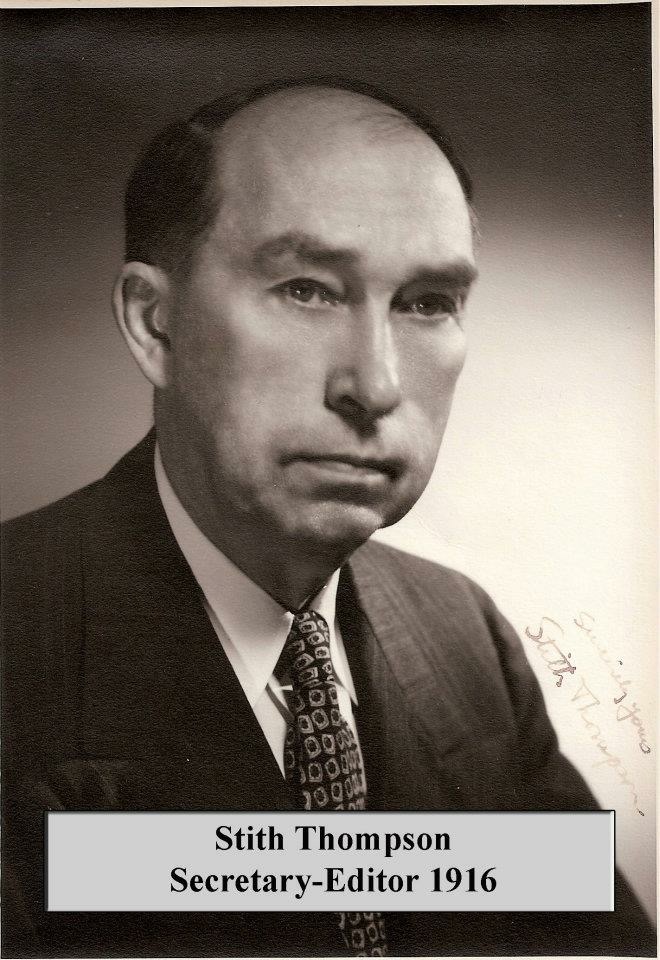 Stith Thompson earned his PhD at Harvard University, studying under George Lyman Kittredge, and arrived at the University of Texas in 1914. Thompson immediately found himself involved with the Society, attending his first meeting in Waco in 1915. The meeting was a resounding success, hosted by President Dorothy Scarbrough. After that meeting, riding the train back to Austin, Lomax and Stith Thompson conceived of the idea of pulling together papers from the first five years' meetings and publishing them. In 1916, Thompson edited that first publication of the Texas Folklore Society, later renamed Round the Levee, while serving as the Society's Secretary and Treasurer. Thompson raised money for the publication and printed 500 copies of the first publication, exceeding the number of charter members by quite a bit. Letters were sent to members encouraging them to send him lists of potential members he could recruit by sending the publication as a sample of the scholarship the Society would encourage, collect, and share. Lomax left UT in 1917, when former Governor James Ferguson had a big row with the University, targeting faculty he deemed to be against him and his interests. The nation was at war in 1917 and 1918, and for a few years the Society lay dormant. Thompson moved to Indiana University in 1921. One of his many contributions to the field of folklore was his six volume Motif-Index of Folk-Literature, which organizes thousands of the categories and subcategories of the elements of folktales, and remains a tool used by scholars today.
Stith Thompson earned his PhD at Harvard University, studying under George Lyman Kittredge, and arrived at the University of Texas in 1914. Thompson immediately found himself involved with the Society, attending his first meeting in Waco in 1915. The meeting was a resounding success, hosted by President Dorothy Scarbrough. After that meeting, riding the train back to Austin, Lomax and Stith Thompson conceived of the idea of pulling together papers from the first five years' meetings and publishing them. In 1916, Thompson edited that first publication of the Texas Folklore Society, later renamed Round the Levee, while serving as the Society's Secretary and Treasurer. Thompson raised money for the publication and printed 500 copies of the first publication, exceeding the number of charter members by quite a bit. Letters were sent to members encouraging them to send him lists of potential members he could recruit by sending the publication as a sample of the scholarship the Society would encourage, collect, and share. Lomax left UT in 1917, when former Governor James Ferguson had a big row with the University, targeting faculty he deemed to be against him and his interests. The nation was at war in 1917 and 1918, and for a few years the Society lay dormant. Thompson moved to Indiana University in 1921. One of his many contributions to the field of folklore was his six volume Motif-Index of Folk-Literature, which organizes thousands of the categories and subcategories of the elements of folktales, and remains a tool used by scholars today.
Dobie, Boatright, and Hudson Era (1921–1971)
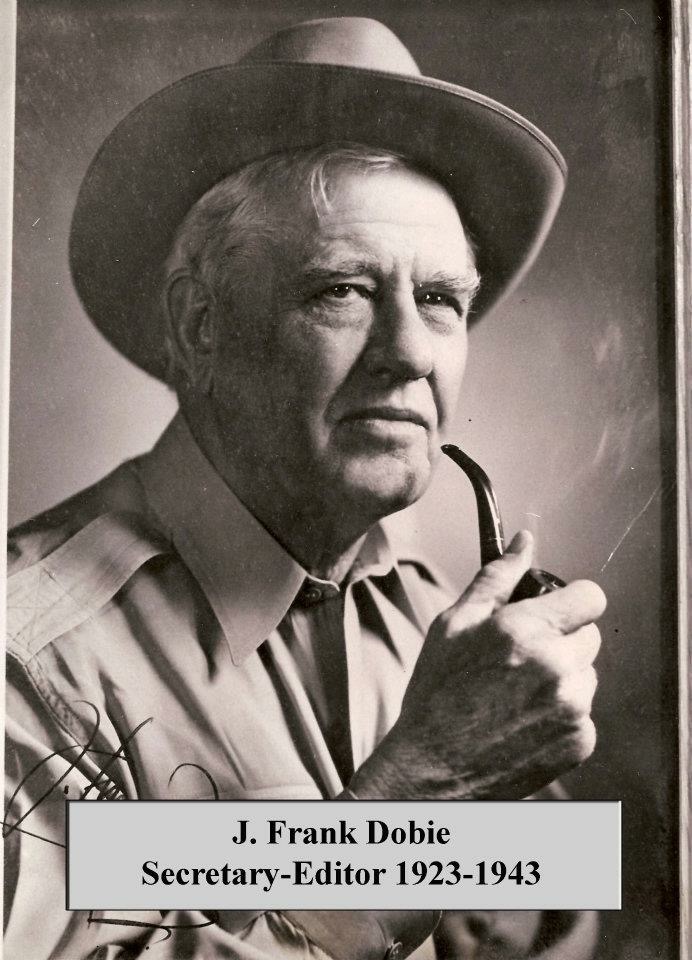 "Organizations are really very fragile affairs. The Society might very well have gone the way of many similar short-lived academic enthusiasms had not a rebuilder, J. Frank Dobie, come along whose purpose in life was the same as the Texas Folklore Society's," wrote F. E. Abernethy in The Texas Folklore Society Volume I. Arriving on campus as a faculty member at the same time as Stith Thompson, Dobie paid his dues in 1915, but it seems that was the extent of his involvement. He enlisted in the Army in 1917 and arrived back at the university in the late spring of 1919. He served a year as a disgruntled faculty member and quit, vowing never to return. He was ready to return to ranching, so took a job managing his Uncle Jim Dobie's Rancho de Los Olmos. It was there, on an evening spent with the vaquero Santos Cortez talking of buried treasures, that it all became clear to him. In that year on the ranch, he had come to realize that folklore was all around him. "I seemed to be seeing a great painting of something I'd known all of my life. I seemed to be listening to a great epic of something that had been commonplace in my youth but now took on new meanings." (Dobie, Some Part of Myself, 236).
"Organizations are really very fragile affairs. The Society might very well have gone the way of many similar short-lived academic enthusiasms had not a rebuilder, J. Frank Dobie, come along whose purpose in life was the same as the Texas Folklore Society's," wrote F. E. Abernethy in The Texas Folklore Society Volume I. Arriving on campus as a faculty member at the same time as Stith Thompson, Dobie paid his dues in 1915, but it seems that was the extent of his involvement. He enlisted in the Army in 1917 and arrived back at the university in the late spring of 1919. He served a year as a disgruntled faculty member and quit, vowing never to return. He was ready to return to ranching, so took a job managing his Uncle Jim Dobie's Rancho de Los Olmos. It was there, on an evening spent with the vaquero Santos Cortez talking of buried treasures, that it all became clear to him. In that year on the ranch, he had come to realize that folklore was all around him. "I seemed to be seeing a great painting of something I'd known all of my life. I seemed to be listening to a great epic of something that had been commonplace in my youth but now took on new meanings." (Dobie, Some Part of Myself, 236).
Dobie returned to the university in the Fall of 1921, fully focused on his goals and he knew that the University of Texas and the Texas Folklore Society were going to help him achieve those goals. He gathered the Society leaders and set out to take up where the Society had left off. The eighth annual meeting was held in 1922. Soon after, Dobie started work on the 1923 PTFS II, Coffee in the Gourd. Dobie recognized a good story and was the force behind not only reviving the Society, but also stabilizing it as well as acting as champion for the annual publication. When Dobie left to teach at an Oklahoma college, Payne filtered correspondence to Dobie and the two ran the organization by mail. Dobie returned to UT in 1926. He took up the campaign to "save the longhorns" and made a recommendation to the state legislature through a resolution issued by the Texas Folklore Society. In 1932, Ben Mead styled the first paisano for the book cover, and minutes reflect the adoption of the bird as the emblem of the Society. Dobie's old-time Texas stockman style differed from that of typical English professors. He revived the Society and rode herd on it, carrying us from the Great Depression, through the 1936 Texas State Centennial and to World War II. His own writing and publishing flourished, and in 1940 he sought to hand over the duties as Secretary-Editor. The Society didn't meet during WWII, but it did produce a PTFS in 1943. Convinced that the Society was strong, Dobie left for Cambridge in 1943.
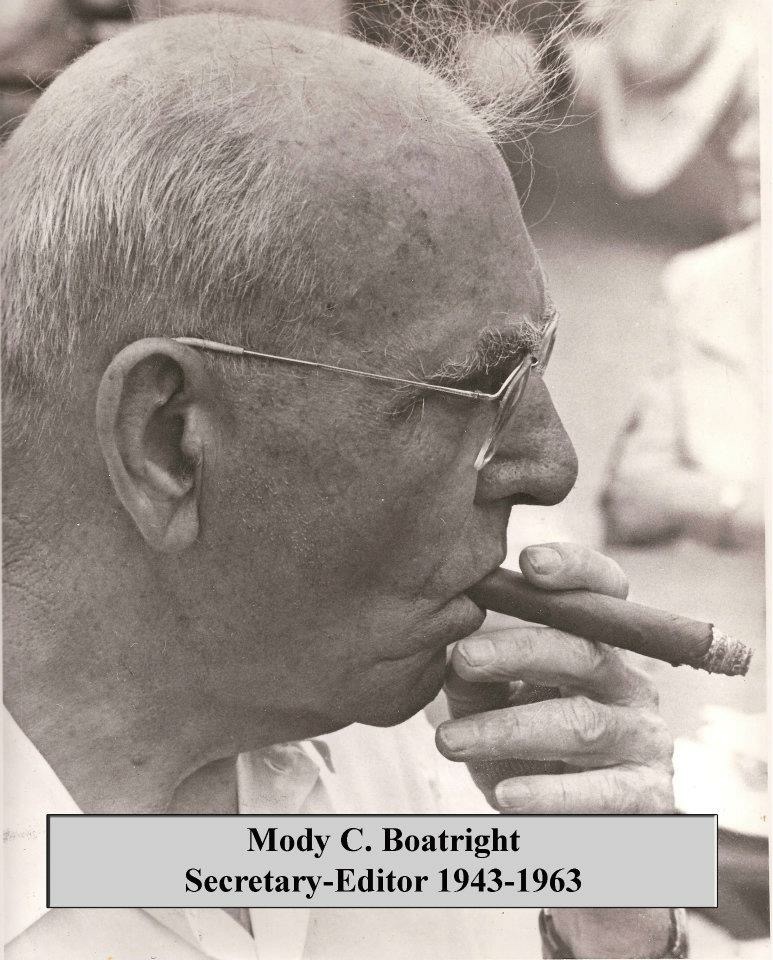 When Dobie left Texas to teach at Cambridge, Mody Boatright, who had served as assistant editor, thought he was merely holding down the fort until Dobie would return. With World War II continuing in both Europe and Japan, the Society vowed to do its part in preserving resources. The Society didn't hold an Annual Meeting in 1944 or in 1945, and Boatright knew he had to do what he could to ensure the Society didn't collapse without a meeting–and without Dobie. Though resources were tight, he ensured the annual publications were pulled together and sent out. When Dobie got back to Texas, to the surprise of many, he declined returning to the helm. Boatright was faced with the rising cost of publications but no corresponding rise in dues paid by members. In 1948, Boatright started sending members a quarterly newsletter, El Paisano including news of the day and a notification that dues would be raised from $2.50 to $3.00 per year. With other duties to attend to, Boatright discontinued the quarterly in March 1950. The 1950s saw years of quiet and years of new vitality. In 1955, Dobie was celebrated as a hero of the Society, and in 1956, member Hermes Nye started the tradition of the hootenanny at Annual Meetings. Boatright is still remembered for his modern take on the roadrunner, crafted in his woodshop at home; now the pieces are considered collectible treasures by members of the Society. Boatright approached folklore as a social scientist, concentrating on scholarly studies rather than on field collecting. Having joined the Society in 1926, Boatright contributed innumerable papers, edited the annual publications, and overall was responsible for keeping the Society afloat during lean times.
When Dobie left Texas to teach at Cambridge, Mody Boatright, who had served as assistant editor, thought he was merely holding down the fort until Dobie would return. With World War II continuing in both Europe and Japan, the Society vowed to do its part in preserving resources. The Society didn't hold an Annual Meeting in 1944 or in 1945, and Boatright knew he had to do what he could to ensure the Society didn't collapse without a meeting–and without Dobie. Though resources were tight, he ensured the annual publications were pulled together and sent out. When Dobie got back to Texas, to the surprise of many, he declined returning to the helm. Boatright was faced with the rising cost of publications but no corresponding rise in dues paid by members. In 1948, Boatright started sending members a quarterly newsletter, El Paisano including news of the day and a notification that dues would be raised from $2.50 to $3.00 per year. With other duties to attend to, Boatright discontinued the quarterly in March 1950. The 1950s saw years of quiet and years of new vitality. In 1955, Dobie was celebrated as a hero of the Society, and in 1956, member Hermes Nye started the tradition of the hootenanny at Annual Meetings. Boatright is still remembered for his modern take on the roadrunner, crafted in his woodshop at home; now the pieces are considered collectible treasures by members of the Society. Boatright approached folklore as a social scientist, concentrating on scholarly studies rather than on field collecting. Having joined the Society in 1926, Boatright contributed innumerable papers, edited the annual publications, and overall was responsible for keeping the Society afloat during lean times.
 With the retirement of Boatright in 1963, Wilson Hudson took the reins. Joining the Society in 1937, Hudson served on the publication team in 1940, and he edited The Healer of Los Almos and other Mexican Lore (PTFS XXIV) in 1951 while Boatright was in California for a while. While Dobie and Boatright had loosened the grip on the definition of folklore, Wilson encouraged the scholarly analysis. He agreed that it was important to make lists or recognize a tale, but that analysis of why a cure worked, or why a tale was told, was important. A great deal of Hudson's era was spent sorting out problems with the press producing the Society's publications and the reprints of past works. He encouraged James T. Bratcher to compile the Analytical Index to the Publications of the Texas Folklore Society, a valuable tool for researchers. Under the protective eye of Hudson, and with the help of Counselor Hermes Nye, the Society became officially incorporated in 1968. By 1970, the membership of the Society had doubled and Hudson was spending much more time managing the publications and fielding reprint requests without an editorial staff. Hudson asked the university administration to reduce one course from his teaching schedule in order to take care of the Society's business, but the request was declined.
With the retirement of Boatright in 1963, Wilson Hudson took the reins. Joining the Society in 1937, Hudson served on the publication team in 1940, and he edited The Healer of Los Almos and other Mexican Lore (PTFS XXIV) in 1951 while Boatright was in California for a while. While Dobie and Boatright had loosened the grip on the definition of folklore, Wilson encouraged the scholarly analysis. He agreed that it was important to make lists or recognize a tale, but that analysis of why a cure worked, or why a tale was told, was important. A great deal of Hudson's era was spent sorting out problems with the press producing the Society's publications and the reprints of past works. He encouraged James T. Bratcher to compile the Analytical Index to the Publications of the Texas Folklore Society, a valuable tool for researchers. Under the protective eye of Hudson, and with the help of Counselor Hermes Nye, the Society became officially incorporated in 1968. By 1970, the membership of the Society had doubled and Hudson was spending much more time managing the publications and fielding reprint requests without an editorial staff. Hudson asked the university administration to reduce one course from his teaching schedule in order to take care of the Society's business, but the request was declined.
Stephen f. Austin state university, Nacogdoches
Abernethy (1971–2004)
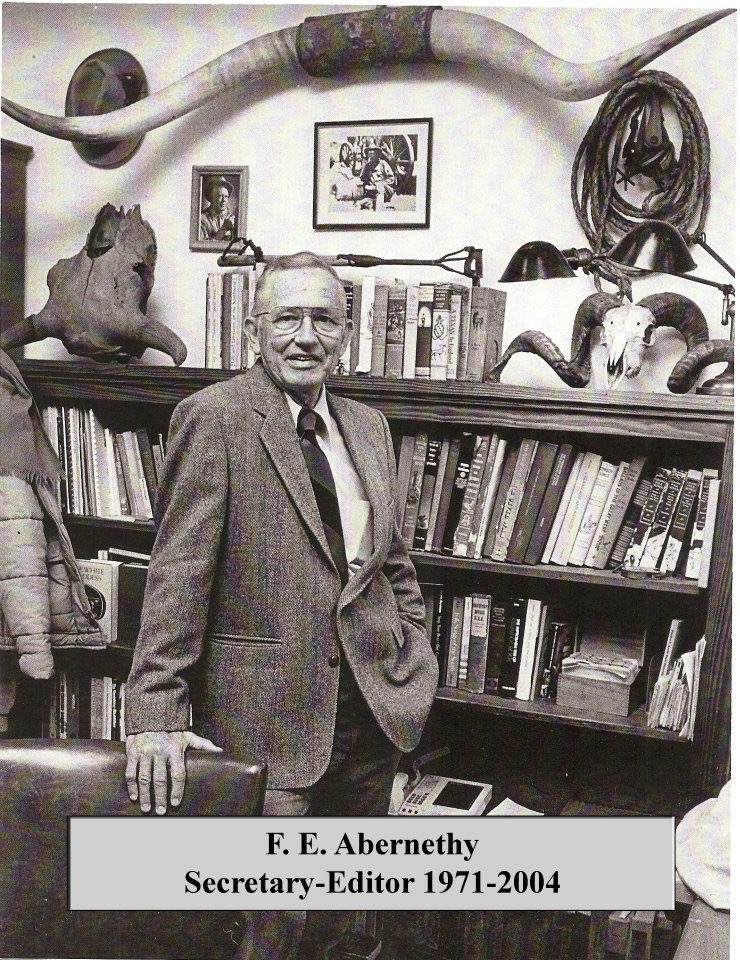 With the retirement of Hudson, the Society needed a new Secretary-Editor and, for the first time, didn't have anyone who already had served on the editorial staff. Francis E. "Ab" Abernethy, an English professor and member of the Society, stepped forward as a candidate. The nominating committee agreed to the choice, if Ab's school would provide adequate support, which was successfully negotiated. On a hot August day in Austin, Hudson and Abernethy loaded the station wagon with the goods of the Society and headed northeast for Stephen F. Austin State University in Nacogdoches. Ab was an independent leader who was charismatic and full of good humor. His talents in music contributed mightily to renewed interest in folk songs. In the 60s, a young Janis Joplin sat in on some of his classes. She knew that the 1965 annual meeting would be in Austin and asked Ab if she could sing at the hootenanny. Ab recalled being a little worried about how that might go, but to his delight, it was a happy surprise for those in attendance. As with previous Secretary-Editors, Abernethy put his stamp on the parameters of folklore, trying to make the field open and accessible to all. Abernethy said we were at our best when the amateurs were in the majority, despite the fact that he was an academician himself. He was a gifted musician and was often the leader of the hootenannies at our gatherings. Thirty-three years after he took the job, Abernethy retired, making him the longest-serving editor to date.
With the retirement of Hudson, the Society needed a new Secretary-Editor and, for the first time, didn't have anyone who already had served on the editorial staff. Francis E. "Ab" Abernethy, an English professor and member of the Society, stepped forward as a candidate. The nominating committee agreed to the choice, if Ab's school would provide adequate support, which was successfully negotiated. On a hot August day in Austin, Hudson and Abernethy loaded the station wagon with the goods of the Society and headed northeast for Stephen F. Austin State University in Nacogdoches. Ab was an independent leader who was charismatic and full of good humor. His talents in music contributed mightily to renewed interest in folk songs. In the 60s, a young Janis Joplin sat in on some of his classes. She knew that the 1965 annual meeting would be in Austin and asked Ab if she could sing at the hootenanny. Ab recalled being a little worried about how that might go, but to his delight, it was a happy surprise for those in attendance. As with previous Secretary-Editors, Abernethy put his stamp on the parameters of folklore, trying to make the field open and accessible to all. Abernethy said we were at our best when the amateurs were in the majority, despite the fact that he was an academician himself. He was a gifted musician and was often the leader of the hootenannies at our gatherings. Thirty-three years after he took the job, Abernethy retired, making him the longest-serving editor to date.
Untiedt (2004–2020)
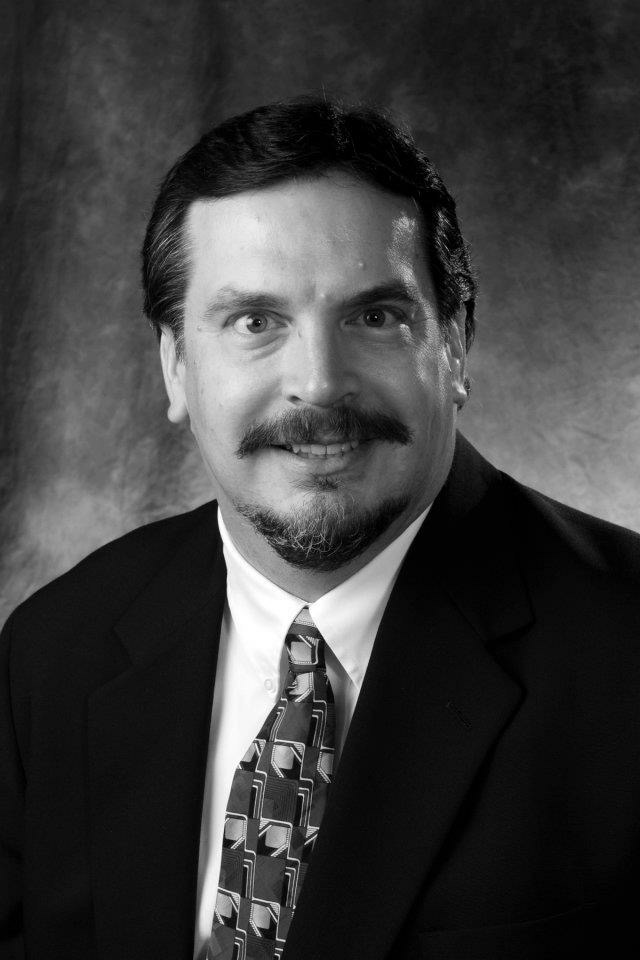 With Ab's upcoming retirement, in 2004 the nominations committee chose Kenneth Untiedt as the next Secretary-Editor. Longtime member Kenneth Davis, who taught folklore at Texas Tech University, had introduced Untiedt to the Society by inviting him to present papers at the annual meetings in 1995 and 1998. During his sixteen years as Secretary-Editor, Untiedt edited eleven publications, some of them collections of papers contributed by members and others the "extra books" which came from single authors. Like Secretary-Editors before him, Untiedt paid homage to his predecessor, F. E. Abernethy, in 2016 by publishing Thirty-three Years, Thirty-three Works. Recognizing the opportunity to reach young members of the community and of the Society, Untiedt founded, organized, and operated a Kids Folklore Camp called "Treetops in the Forest". He also encouraged college students to present papers at our meetings and to submit their stories when a call for papers went out for our books. Untiedt broadened the outreach of the Society, representing the organization and presenting papers at conferences, including those of the American Folklore Society, East Texas Historical Association, West Texas Historical Association, and Texas State Historical Association.
With Ab's upcoming retirement, in 2004 the nominations committee chose Kenneth Untiedt as the next Secretary-Editor. Longtime member Kenneth Davis, who taught folklore at Texas Tech University, had introduced Untiedt to the Society by inviting him to present papers at the annual meetings in 1995 and 1998. During his sixteen years as Secretary-Editor, Untiedt edited eleven publications, some of them collections of papers contributed by members and others the "extra books" which came from single authors. Like Secretary-Editors before him, Untiedt paid homage to his predecessor, F. E. Abernethy, in 2016 by publishing Thirty-three Years, Thirty-three Works. Recognizing the opportunity to reach young members of the community and of the Society, Untiedt founded, organized, and operated a Kids Folklore Camp called "Treetops in the Forest". He also encouraged college students to present papers at our meetings and to submit their stories when a call for papers went out for our books. Untiedt broadened the outreach of the Society, representing the organization and presenting papers at conferences, including those of the American Folklore Society, East Texas Historical Association, West Texas Historical Association, and Texas State Historical Association.
Tarleton State University, stephenville
Vick (2020–2021)
 In April 2020, the Society's annual in-person meeting was cancelled due to the coronavirus pandemic. An electronic vote was taken, and the membership agreed to move the Society to host institution Tarleton State University in Stephenville, and to elect longtime member and Fellow Frances B. Vick as the Society's first female Secretary-Editor. Fran is a native of East Texas and was raised surrounded by cultural traditions of her family and the community. Once grown, she was surprised (as are most of us) that everything around her had been “folklore.” From there, Fran’s description of folklore is simple, “It’s about the folk. It’s about what they do and how they do it.” Fran is highly regarded as a publisher, historian, writer, and folklorist. She was named a Fellow of the Texas Folklore Society in 2006.
In April 2020, the Society's annual in-person meeting was cancelled due to the coronavirus pandemic. An electronic vote was taken, and the membership agreed to move the Society to host institution Tarleton State University in Stephenville, and to elect longtime member and Fellow Frances B. Vick as the Society's first female Secretary-Editor. Fran is a native of East Texas and was raised surrounded by cultural traditions of her family and the community. Once grown, she was surprised (as are most of us) that everything around her had been “folklore.” From there, Fran’s description of folklore is simple, “It’s about the folk. It’s about what they do and how they do it.” Fran is highly regarded as a publisher, historian, writer, and folklorist. She was named a Fellow of the Texas Folklore Society in 2006.
If you'd like to know more about our history, we have a three-volume set that tells it all from 1909-2000. Written by F. E. Abernethy, the volumes are arranged chronologically and cover briefly what was going on in the world at the time, to put into perspective what was going on within the Society. There are lists of papers given, descriptions of members and presidents, photographs, annual meeting information, funny stories, struggles of staying afloat, and the birth of the hootenanny as a tradition with the Society. Under the various tenures of Secretary-Editors, we've seen the ebb and flow of membership numbers, money in the bank, more academics than amateurs, and then the reverse. The key to our continuance, despite our differences, has always been our appreciation of those differences and our love and respect for one another. Click here to learn more about Volume I of the set.
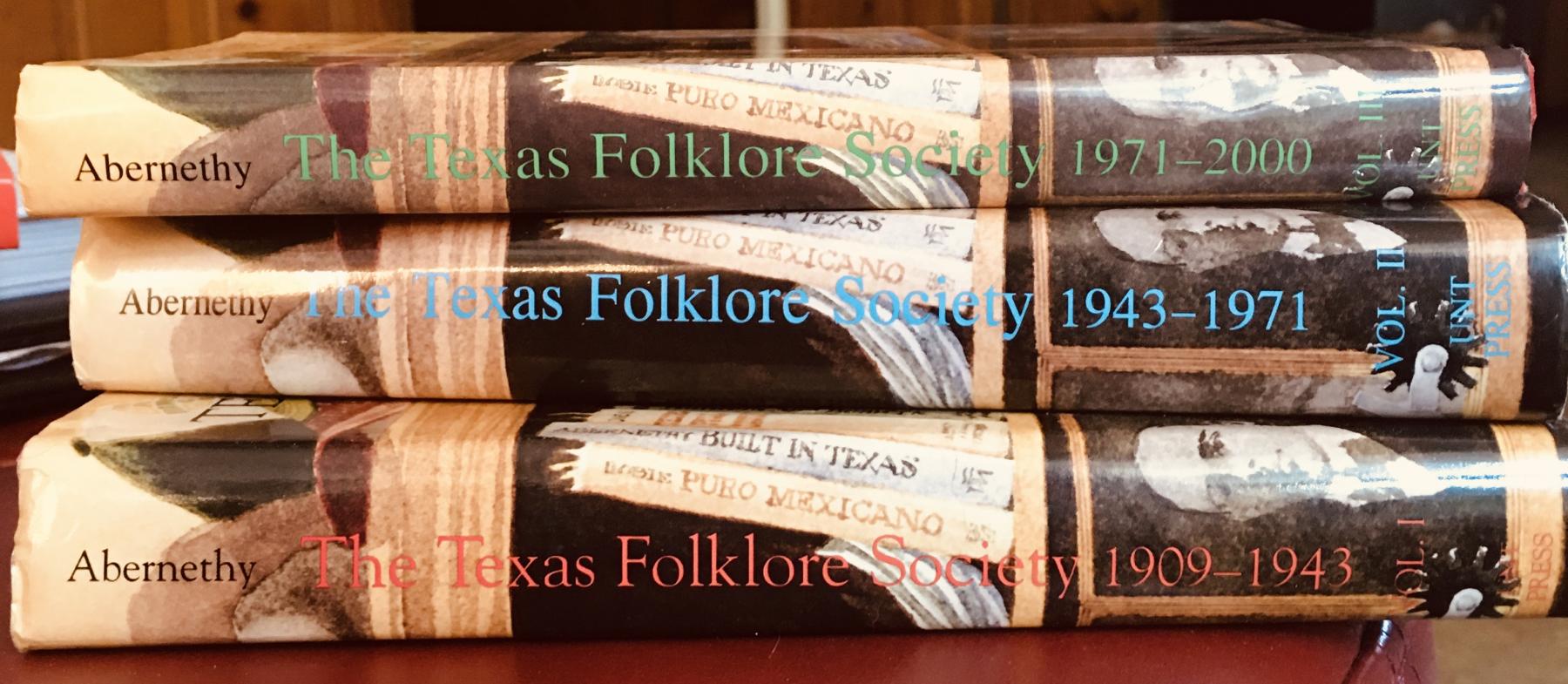








 In April 2020, the Society's annual in-person meeting was cancelled due to the coronavirus pandemic. An electronic vote was taken, and the membership agreed to move the Society to host institution Tarleton State University in Stephenville, and to elect longtime member and Fellow Frances B. Vick as the Society's first female Secretary-Editor. Fran is a native of East Texas and was raised surrounded by cultural traditions of her family and the community. Once grown, she was surprised (as are most of us) that everything around her had been “folklore.” From there, Fran’s description of folklore is simple, “It’s about the folk. It’s about what they do and how they do it.” Fran is highly regarded as a publisher, historian, writer, and folklorist. She was named a Fellow of the Texas Folklore Society in 2006.
In April 2020, the Society's annual in-person meeting was cancelled due to the coronavirus pandemic. An electronic vote was taken, and the membership agreed to move the Society to host institution Tarleton State University in Stephenville, and to elect longtime member and Fellow Frances B. Vick as the Society's first female Secretary-Editor. Fran is a native of East Texas and was raised surrounded by cultural traditions of her family and the community. Once grown, she was surprised (as are most of us) that everything around her had been “folklore.” From there, Fran’s description of folklore is simple, “It’s about the folk. It’s about what they do and how they do it.” Fran is highly regarded as a publisher, historian, writer, and folklorist. She was named a Fellow of the Texas Folklore Society in 2006.
